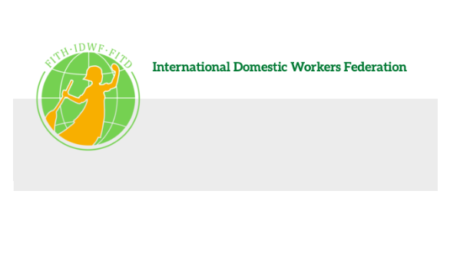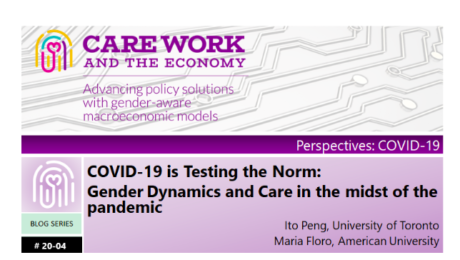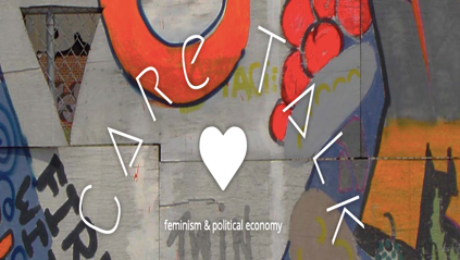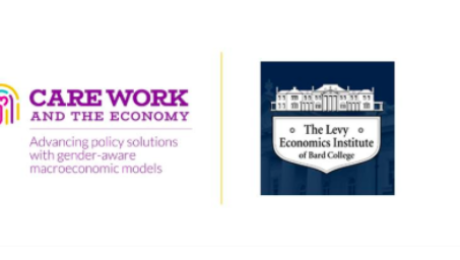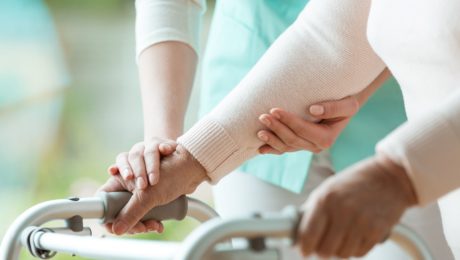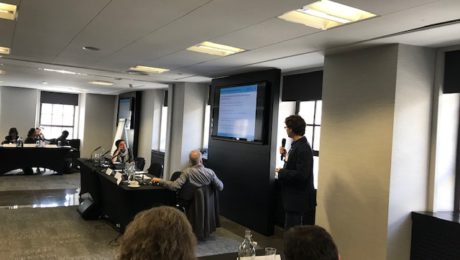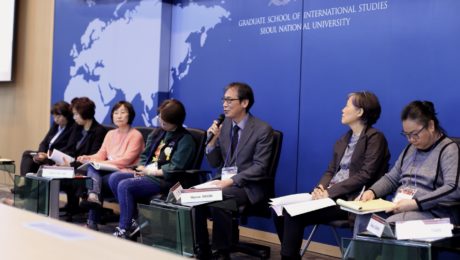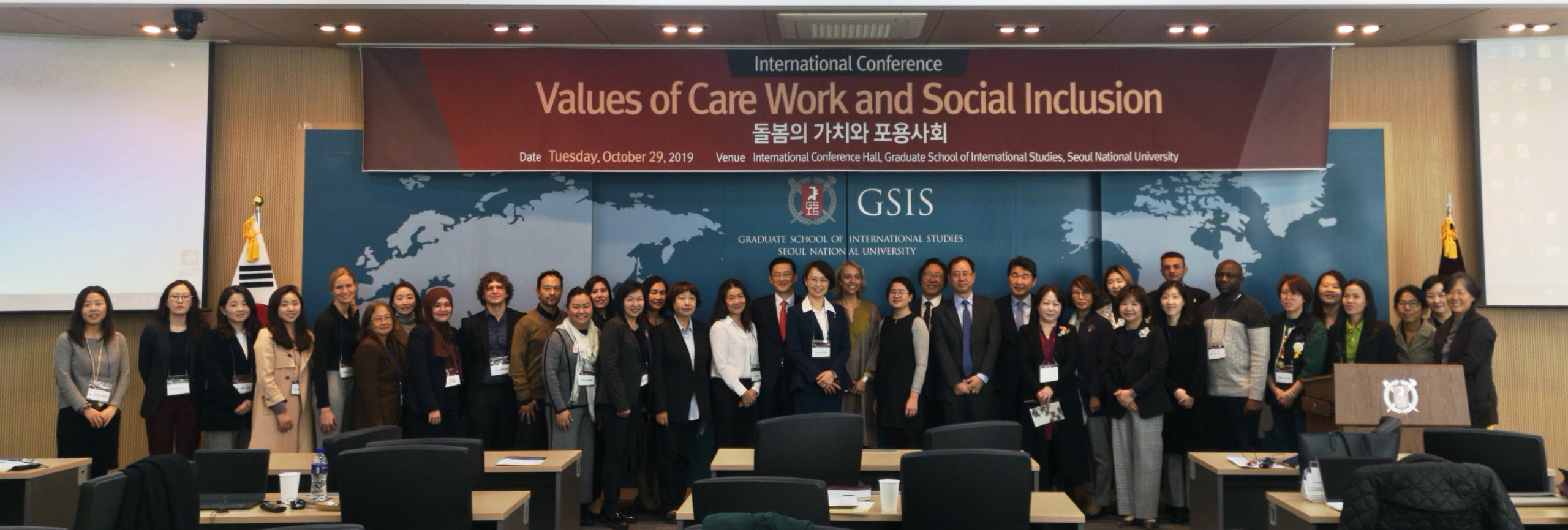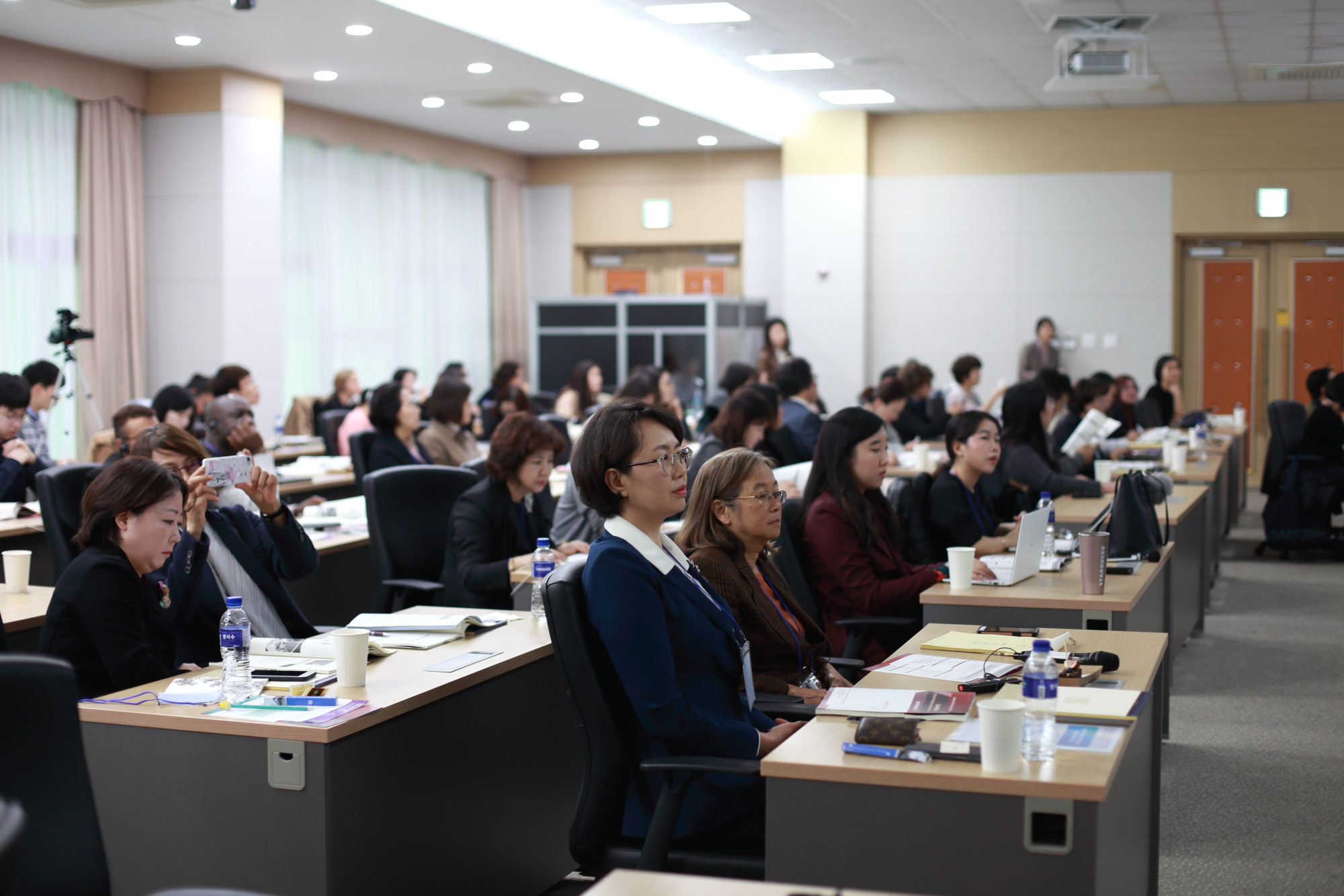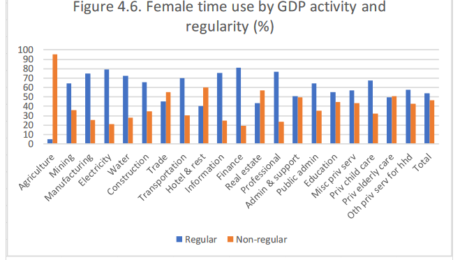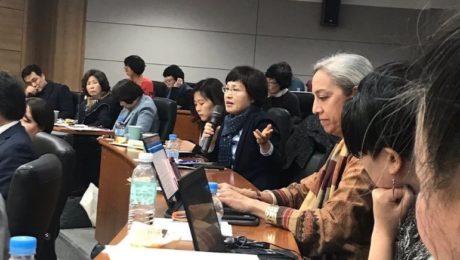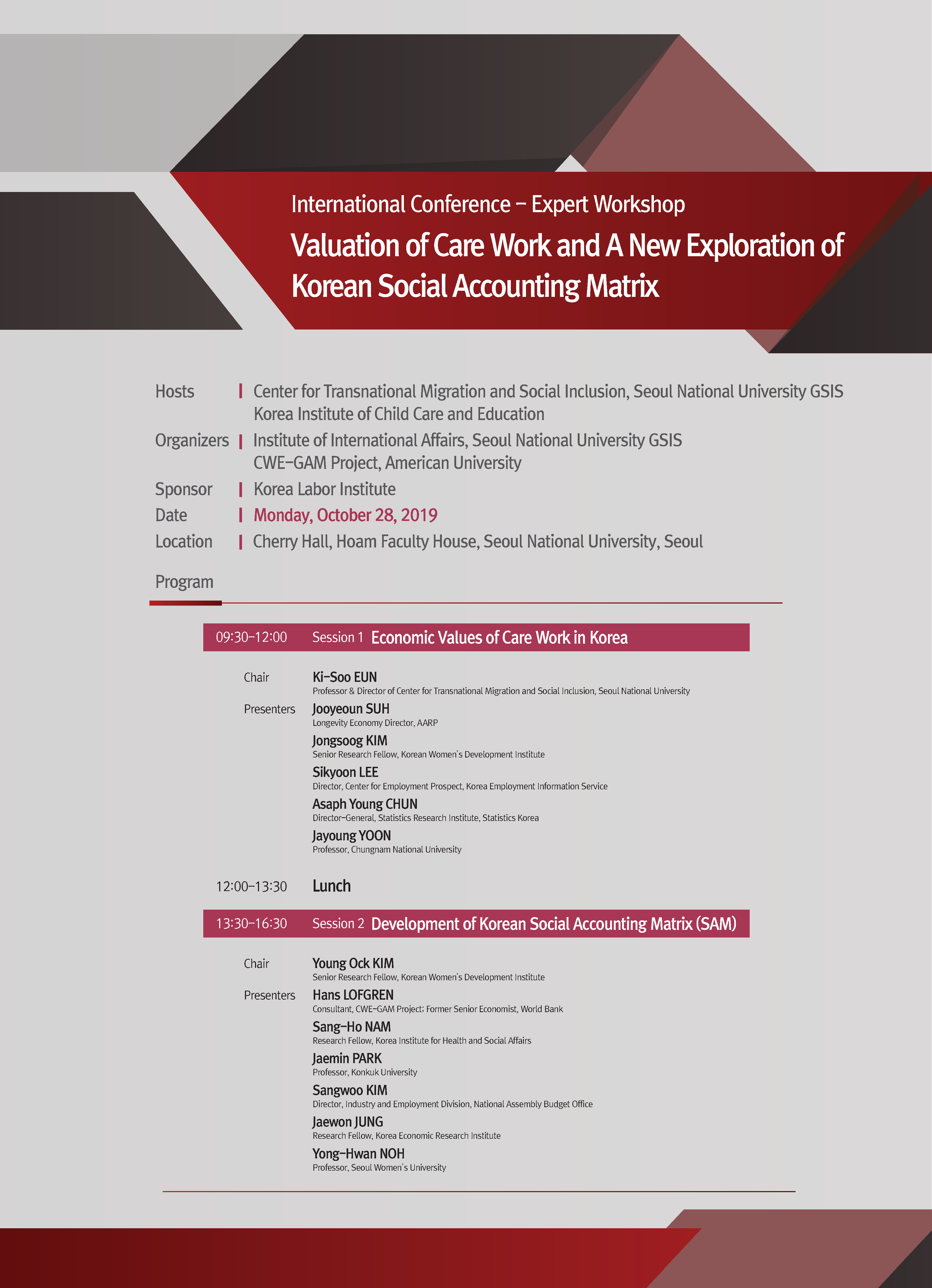Domestic and Care Workers Under COVID-19
By definition, domestic workers are an essential part of the global care workforce. According to the ILO, there are 70 million domestic workers over the age of 15 working directly for private households. They therefore make up roughly 22.7% of the global care workforce (which number 308,6 million).[1] Since its foundation in 2013, the International Domestic Workers Federation (IDWF) has worked with global unions and key audiences with the aim of including home care workers into the global agenda on “care” and to fight for the improvement of their living and working conditions.
Work in the care sector changes rapidly due to aging populations in the west and the more industrialized part of Asia. Financial demands on families who rely on unpaid care work, or the reliance by governments on private and not-for-profit sectors to play an increasing role in providing services. In Asia, most governments deny labour rights and working conditions, particularly for migrant workers, In the west, there is an increasing number of undocumented migrant domestic workers and they do not enjoy labour rights protection due to their vulnerable status. In recognition of the challenges in care work, in 2018 the IDWF Congress adopted two Resolutions (No. 3 & 4) to guide the Federation’s work and address global demands on developing inclusive care systems, special protection programs, and special attention to undocumented and migrant worker’s needs.
The new coronavirus pandemic has impacted all regions for more than three months. Domestic, household and care workers are on the frontlines in keeping families and communities healthy, but they are also most at risk. COVID19 has increased the vulnerability of the sector, which is already and broadly characterized by lack of protections, social security or recognition in many places of the world.
The IDWF consists of 74 affiliates in 57 countries, representing almost 600,000 domestic workers. Since the pandemic began, the IDWF has been actively engaging with affiliates in all regions to monitor the situation on the ground. In many countries, workers are experiencing a substantial increase in workload to ensure cleanliness and hygiene; or in taking care of older people and people with existing medical conditions.
The most critical issues identified:
– Domestic and care workers, especially the live-out/ part time are the most vulnerable group. They cannot move around and lose their jobs due to the lockdowns and social distancing rules, or their employers no longer call them in to work. Many have endured this situation for several weeks while others are losing their jobs with no prospects of finding new sources of income.
-Without income, migrant workers are especially vulnerable as they try to survive in the destination countries. In many countries, migrant workers are not eligible for medical services and hence do not get COVID-19 tests, places for quarantine or medical treatment when needed.
-Workers from rural areas working in the cities, cannot return to their families, or access relief packages provided by local governments.
-The lack of medical and social protections benefits renders domestic and care workers unprotected even when they are sick or need to be quarantined with no remuneration. IDWF and Affiliates are monitoring the mortality rates of members, a difficult task as many governments do not test or report incidents.
-Despite the essential work, domestic and care workers face increasing discrimination during the pandemic. Many workers report for being blamed for bringing the virus into their employers’ homes.
-The ability of domestic workers unions to keep their offices functioning is also compromised during quarantine or semi-quarantine time. Many unions are able to pay for the basic services and provide essential support (i.e. information, food baskets, training) from income previously generated. It is essential that union offices keep operating and maintaining their services for a range of situations that go from unfair dismissals to gender based violence.
In this situation, most organizations have shifted or stopped normal activities. With exception to those in North America and Europe, most organizations are struggling to find ways and means to address emergencies. Some countries have included domestic workers in their relief programs while others have joined hands with allies to demand governments to give out wages /cash, food, masks, sanitizers, places for quarantine. As the pandemic continues, so will the crisis on the ground.
Based on its assessment, the IDWF will continue to do research and collect data to inform advocacy. The IDWF will also set up a solidarity fund to address some of the most critical needs to enable domestic/care workers –and their families– to cope and survive with COVID-19.
[1] ILO (2018), Geneva. Care Work and Care Jobs For the Future of Decent Work.
Contributed by Sofia Trevino, Sustainability Advisor for International Domestic Workers Federation (IDWF) and the Project Manager for Women in Informal Employment Globalizing and Organizing (WIEGO)
Relevant Links:
IDWF: Decent work for Domestic Workers: Eight Good Practices from Asia
In IDWF site, resources on care work (books, articles, websites, audio)
An essay collection on Care economy: Three Years of Collective and Global Learning About Care
ILO Decent Work in the Care Economy
Care Needs and Migration for Domestic Work: Poland and Ukraine
Migrant Domestic Workers: Promoting Occupational Safety and Health
Expanding Social Security to Migrant Domestic Workers
IDWF Resolutions adopted by the 2nd Congress in 2018, Cape Town, South Africa
ILO: Social Protection for Domestic Workers: Key Policy Trends and Statistics
ILO World of Work Magazine: Violence at Work
Decent Work for Domestic Workers: Eight Good Practices from Asia, ILO and IDWF
Why We Care about Care: An Online Moderated Course on Care Economy, UN Women
Research Network of Domestic Workers Rights
WIEGO:
UN High Level Panel Report on Child Care by Rachel Moussié, Deputy Director of WIEGO Social Protection Programme.
Counting the World’s Informal Workers: A Global Snapshot
The ILO – WIEGO policy brief series on childcare for informal workers
Sofia Trevino is the Sustainability Advisor for International Domestic Workers Federation (IDWF) and the Project Manager for Women in Informal Employment Globalizing and Organizing (WIEGO)
- Published in Child Care, COVID 19, Domestic Workers, Policy Briefs & Reports
COVID-19 is Testing the Norm: Gender Dynamics and Care in the Midst of the Pandemic
The COVID-19 crisis has upended lives around the world. It has forced cities and countries to enforce lockdown and social distancing regulations. Schools and businesses are closed and people are told to self-isolate, stay home, telework (if your job allows), to not go out except to get essential things, and care for each other but in distance. For those who live on their own, COVID-19 is about learning to live with solitude and loneliness, except for the occasional video, online or phone chats. For others who are living in a family, it is about living together in a confined space, 24/7, balancing work and family responsibilities, and rearranging the share of housework. The COVID-19 crisis is not just leaving a trail of human and economic sufferings; it is also testing prevailing gender norms as it confines both paid and unpaid work activities for many households within the same space.
Amongst the many lessons that the COVID-19 pandemic is teaching us, one of the most important is the centrality of care in maintaining a healthy, balanced and functional society and economy. Additionally, how much of that care is implanted in and shaped by our social and cultural norms. These norms vary by culture, class, caste, ethnicity, religion, and life cycle stage. Before the COVID-19, most of us had regular normal lives: during week days, children went to schools and adults either went to work or were looking for work. Frail elderly and disabled people were given necessary care by family members, relatives, domestic/ personal service workers or care service institutions. During weekends and holidays, social, religious, cultural, and leisure activities alongside weekend domestic chores filled people’s time.
But that was before the COVID-19; it is not the same anymore. The stay-at-home, social distancing and travel restrictions have forced household members to be physically together day and night. Without the vital and often taken-for-granted services such as daycares, after school programs, and community centre activities, and without opportunities to engage in social activities with other people, many households are suddenly faced with the challenges of having to both doing market work and care for their children as well as the sick, disabled, and frail elderly member needing care. It seems that the lived experiences of informal home-based women workers are now shared by millions around the world who have dependents: the constant juggling of different demands on one’s time and the stress of having to frequently multi-task. On one hand, there is the increased level of unpaid work that needs to be done, and on the other, the necessity to earn one’s livelihood from home. Many households therefore are faced with – for the first time – the imperatives of having to share the heavy burden of unpaid work. Will it be the usual division of household work as in ordinary “normal” times? Or will the situation at hand involve new negotiations and allow some upending of gender roles?
In unexpected ways, the COVID-19 health crisis has opened windows for women and men to see and experience the other “gender” role up close and personal: those not in the labor force see and hear the day-to-day business of earning a living ala “online”, while the “breadwinners” see and hear children needing attention, help with schoolwork, crying in the background, etc. In some households, men are now more willing to take on more care work, do the laundry, clean house and cook some meals. But in other households, the current situation may intensify existing unequal gender relations and heighten tensions. Male household heads for example, may deliberately utilize traditional gender norms to maintain discipline and control. For example, women are expected to find ways of combining childcare and market work by multi-tasking or lengthening their workday in order to reduce to the minimum any distraction or job interruptions to the head. In other cases, the angst associated with no social contacts or support, employment-related anxiety and growing economic insecurity may lead to increased drinking, rising tensions and even domestic violence. Fearful of the loss of their masculine identity, men may reinforce women’s submission to patriarchal rules in the household. Unfortunately, the situation created by the COVID-19 limits the options for women to seek help when they face threats to violence or are victims.
As social norms continue to evolve and traditional gender roles within households are tested in varied ways, one thing is clear: the COVID-19 crisis is exposing, and disrupting, the core system that supports our society and underpins our economy – the mixed economy of care. In ordinary or “normal” times, our lives are made manageable and our economy sustainable because different social institutions are providing different kinds of care in both paid and unpaid forms. These include public and private institutions, such as schools, hospitals, community centers and other social and community services providing essential health, education, and other social services; within the household (mainly women) doing unpaid essential care and domestic work. We take for granted this care delivery system, especially those institutional arrangements involving unpaid labour. We forget that care collectively provided by all these institutions play an important role in supporting us socially and economically. The COVID-19 crisis is teaching us that we are all socially and economically interdependent: we all give and receive care throughout our lives, and that we must recognize, understand and find ways to ensure that care work is valued. It is also giving us the opportunity to reflect on how the responsibility for and the cost of providing care can be better shared within households as well as within society – and on how we might better restructure our mixed economy of care.
This blog was authored by Ito Peng and Maria Floro
- Published in COVID 19, Gender Inequalities
Are We All Care Workers Now?
Who, exactly, are care workers, other than the people we need most right now, as the covid-19 pandemic overlays the division of labor with a new division of risk?
I’ve long been an advocate of using the term “care worker” rather than “caregiver” even though the work can be and often is, at least in part, a gift. Because care–whether performed for pay, or not–is at the crux of any sustainable economic system. All work depends on the successful production and maintenance of workers themselves. Yet because this very notion of care-as-work is relatively new, there is little agreement on its exact boundaries.
When I first started pursuing this issue with Paula England, we emphasized hands-on or face-to-face work that develops the capabilities of the care recipient, an essential aspect of the services that health care providers, workers, child care and elder care workers provide. This emphasis could be translated into a specific list of Census-designated occupations, grounding empirical research on the relative pay of care workers that has revealed significant pay penalties for both women and men in such occupations, controlling for many other variables such as education, experience, and unionization.
I liked this broad definition because it spanned paid and unpaid work, low-wage and relatively high-wage occupations, women and men, creating potential for new political alliances. Sociologists initially embraced the definition with some enthusiasm. Not so, economists, and Robert Solow, who attended some meetings of the Russell Sage Foundation Network on Care Work, pushed us for more specificity.
I felt some affinity with Kenneth Arrow’s insistence on the limits of markets and with efficiency-wage theories pointing to the difficulty of monitoring worker productivity, so added another twist to the definition: work in which concern for the welfare of the care recipient is likely to affect the quality of the service provided. In other words, work not performed entirely for money, akin to what some economists have termed “public service motivation” but more…personal.
Still not quite right. Sociologist Mignon Duffy has argued eloquently in Making Care Count that this definition privileges what she calls “nurturant care,” deflecting attention from the drudgery of menial care tasks–the emptying of bed pans, cleaning of toilets, and mopping of floors often performed by the most disempowered members of society. “Dirty” work itself is devalued. Duffy’s work has nudged me to focus more on industry–the economic consequences, for instance, of being employed in health care, education, or social services, regardless of occupation.
The pandemic, however, has pushed me over a cliff, because it is redefining the meaning of “dirty” work–now, any work that increases the risk of exposure to a potentially deadly virus: not just health care, child care, and elder care and unpaid care for family members, but also food services, package delivery, police protection, home repair services, garbage collection…the list goes on. We rely heavily on the motivations of such workers to minimize our own–as well as their own–chances of infection.
The entire sequestration/shelter-in-place/social distancing strategy relies heavily on good will and voluntary compliance. The very invisibility of covid-19 blurs the boundaries between love and money, us and them. The healthy now may later be sick, the sick now may later be dead. When risk is shared, the overlaps between solidarity and self-interest expand.
Yet so many boundaries, however blurry, remain in place. Whether because of who they are or what they do, some workers face much greater risks than others. It’s not enough to cheer them on, to offer them applause or a bit of extra cash.
If we are all care workers now we should do everything in our power to protect our own.
Original blog published on CARE TALK: FEMINIST AND POLITICAL ECONOMY on April 4, 2020. See https://blogs.umass.edu/folbre/
Reposted with permission from Dr. Nancy Folbre from University of Massechusetts Amherst and an expert researcher for the Care Work and the Economy Project
- Published in Child Care, COVID 19, elderly care
A Time for Reflection on Care
The world outside my study is churning and whirling… as it is engulfed with the fast-evolving health situations in communities around the globe. There are many unknowns about the
COVID-19 illness that has spread rapidly in every continent and the presence of uncertainty—big time—has rattled governments, shaken markets, and upended our daily routines, to say the least.
While I join the hundreds of millions of people who constantly check the news online and in newspapers, radio and/or tv, I also take time to pause. These moments allow me to reflect on
what this difficult time that we are all experiencing means and what it says about us—as
individuals, as members of communities, and as citizens of the world.
For one, I find that:
- each individual action has multitudes of rippling effects, large and small, on others;
- the real world oscillates between predictability and unpredictability; it requires each of us to constantly assess the balance between taking caution and taking risk;
- the distinction between self-interest and altruism (promoting others’ interests) becomes more blurred given the pervasive interconnectedness of our lives;
- adaptation and flexibility are vital life skills that we need to have not just now but at all times;
- we have the ability to change as we obtain more information and as conditions around us change; the notion of fixed tastes and preferences is outmoded;
- the skills that we must hone and develop should prepare us not only to live in a competitive world but also to be able to work together, coordinate and cooperate with one another; for the greater good requires collective action.
As the impacts of the COVID-19 spread intensify, there is growing recognition among governments and the public that traditional efforts for dealing with shocks and managing risks through conventional emergency responses are inadequate. Strategic thinking is needed as much as the ability to respond quickly and to take proactive measures. There is an urgent need to build the adaptive capacity and longer-term resilience of communities and societies.
One striking fact about the current global pandemic is its tremendous effect on the care sector. This includes not only the health care systems employing doctors, nurses, aides, and other health professionals but also the unpaid care labor provided by family members, neighbors, and kin.
Many are changing their daily life patterns to provide further assistance and care support for those who are vulnerable such as their parents or grandparents and for those who are self-quarantined. Many more are willing to take the risk of exposure to care for those who have tested positive and are ill but are staying at home because the healthcare system is inadequate, inaccessible, and/or overwhelmed. The shutdown of schools and daycare centers further adds demand for unpaid care. Parents are struggling to care for their children while at the same time trying to tele-work from home.
“How can I write or have meetings with my six-year old around?”
The cloak or mantle that hides the emerging crisis of social reproduction, or the under- provision of care for people who depend on it, is removed. This global pandemic exposes the heavy demand on those who carry the responsibility for providing care for the sick, the young and the frail elderly, the vast majority of whom have been women. It has upended preconceived notions such as: each individual is a ‘Robinson Crusoe’ in families that can find their own solutions to provide care, and that one’s ability to pay should determine who accesses care in the private sector.
The Care Work and the Economy Project joins the efforts of other organizations, research institutions and advocacy groups towards making the care sector visible to policymakers. The heavy care burden that is now being shouldered by health care systems, households, communities and countries throughout the world makes it imperative to bring care work out of statistical shadows and to remove the veil of ignorance in economic policymaking.
Let us hope that this time is truly different and that the jolt brought about by the current pandemic leads to more openness in the academic community and among policymakers towards a paradigm shift and policy change.
March 2020
- Published in Child Care, COVID 19, elderly care, Maria Floro, Policy
Policy Brief for Gendering Macroeconomic Analysis and Development: A Theoretical Model for Gender Equitable Development
The CWE-GAM team presents an engendered macroeconomic model as a tool to analyze the role of gender equality and fiscal policy on growth and development.[1]The model incorporates realistic structural features of a market economy –such as excess production capacity and involuntary unemployment– and incorporates an unpaid reproductive sector as well as the physical and social sectors in the public and private market economy. The addition of the unpaid reproductive sector explicitly incorporates the provision of domestic care, establishing a more holistic representation of how the workforce is kept fed, healthy, and able to work. This three-sector model is designed to serve as a tool for policy analysis and gender-responsive budgeting to develop a policy mix targeted toward more gender-equitable development. This brief provides a general overview of the model and example policy analyses.
For complete details of the model and discussion of related literature, please see the full working paper published to the Care Work and the Economy website click here
- Published in Economic Modeling, Gender Inequalities, Policy Briefs & Reports
A Gendered Social Accounting Matrix for South Korea
A social accounting matrix (SAM) is an economy-wide consistent representation of the payments in an economy, linking production, primary factors, and institutions (the latter often split into households, government, and the rest of the world). In the words of Round (2003), “it is a comprehensive, flexible, and dis-aggregated framework which elaborates and articulates the generation of income by activities of production and the distribution and redistribution of income between social and institutional groups.” Most of the time, a SAM refers to the economy of a country for one year. It may be used to describe the structure of an economy and as a data input to economic models, most importantly CGE models. This paper documents a gendered Social Accounting Matrix (SAM) for South Korea for 2014: the steps followed in its construction, the data sources, and what the SAM says about the economic structure of this country (for brevity from now on referred to as Korea), including gender, time use, and the role of households in providing care and other services provided by households. The SAM that is presented is the key data input to a forthcoming analysis of gender and care in Korea’s economy based on GEM Care, a computable general equilibrium (CGE) model.
At an aggregate level, the value-added in the GDP economy is roughly 86 percent of the total (with agriculture, industry, services accounting for 2, 33, and 51 percent, respectively) and the non-GDP economy 14 percent. This information may be contrasted with aggregate time shares in terms of which, the non-GDP economy accounts for a much larger share, 40 percent. If leisure also were included, then it would on its own account for 50 percent of total time, 53 percent for men and 47 percent for women. The share of time allocated to household activities are drastically different for men and women, 15 and 57 percent, respectively. For women, non-care household services comprise the largest time using activity by a wide margin, followed by household childcare, trade services, and hotel and restaurant services. For men, manufacturing dominates, followed by trade services, household non-care services, and construction. For agriculture and industry, the lesser educated dominate all activities except electricity for both men and women. For services, the differences across sectors are drastic with some dominated by those with high education and others by those with low. These are few of the many descriptive findings from the gendered SAM developed by the authors.
This paper will be available December 2019.
This blog was authored by Binderiya Byambasuren, Kijong Kim & Hans Lofgren

